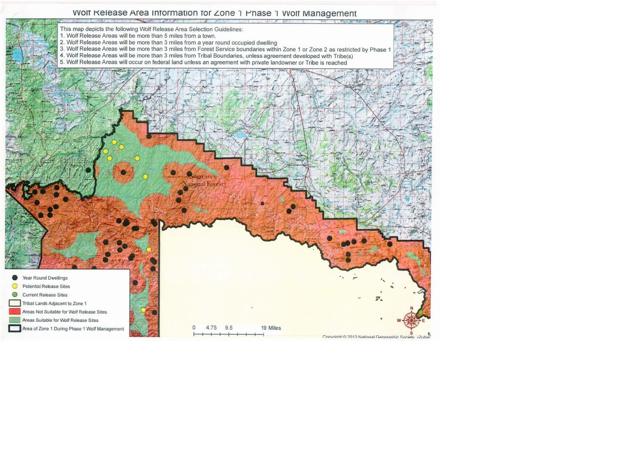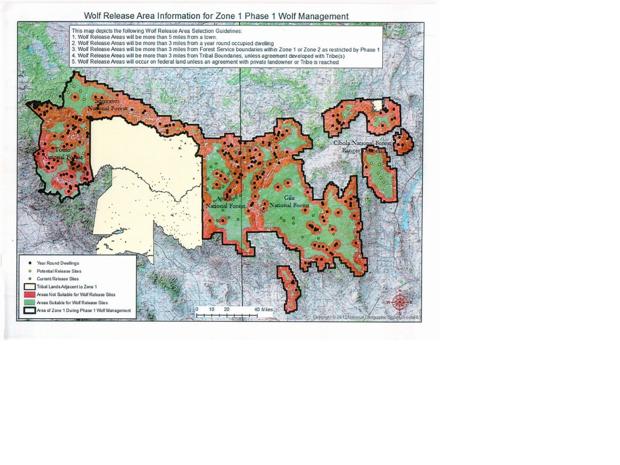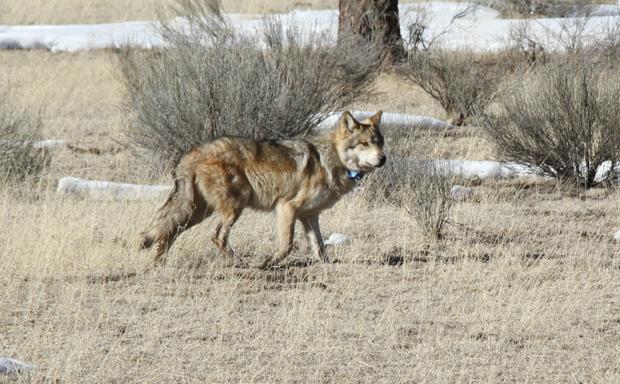Earlier this month, ranchers, federal
forest and wildlife officials and local government representatives
crowded into a Forest Service conference room in Heber. They were there
to discuss a topic many locals have long opposed: the expansion of
Mexican gray wolf releases into a much larger area of Arizona and New
Mexico.
The meeting was an effort to get feedback from the ranchers, who have grazing leases on the land, about sites the Service is considering for future wolf releases in the Tonto and Apache Sitgreaves national forests.
The preliminary maps they were looking at, which are still under consideration, show that of nine proposed locations across the Sitgreaves and Tonto national forests, six are near the southeastern corner of Coconino County. The proposed spots appear to be just west of the Navajo-Coconino County line, approximately five to 10 miles east of State Highway 87.
While necessary for the threatened animals’ survival, the expanded releases bring the wolves closer to ranches, roads and communities that so far have only viewed the issue from far away.
“Many of these folks have not had to deal with the (Mexican wolf recovery) program, so we’re starting from square one,” said Patrick Bray, executive vice president of the Arizona Cattle Growers’ Association.

The U.S. Fish and Wildlife Service and the U.S. Forest Service are currently examining locations in the Tonto and Apache Sitgreaves national forests for future releases of Mexican gray wolves. The yellow dots represent proposed locations for future releases. The locations are still under consideration and may still be moved before they are finalized. The proposed spots are located in the expanded area authorized for releases under a revised rule for managing the wolves that was released in January 2015. For reference, Mormon Lake is at the upper left of the map.
The meeting was an effort to get feedback from the ranchers, who have grazing leases on the land, about sites the Service is considering for future wolf releases in the Tonto and Apache Sitgreaves national forests.
The preliminary maps they were looking at, which are still under consideration, show that of nine proposed locations across the Sitgreaves and Tonto national forests, six are near the southeastern corner of Coconino County. The proposed spots appear to be just west of the Navajo-Coconino County line, approximately five to 10 miles east of State Highway 87.
While necessary for the threatened animals’ survival, the expanded releases bring the wolves closer to ranches, roads and communities that so far have only viewed the issue from far away.
“Many of these folks have not had to deal with the (Mexican wolf recovery) program, so we’re starting from square one,” said Patrick Bray, executive vice president of the Arizona Cattle Growers’ Association.

The U.S. Fish and Wildlife Service and the U.S. Forest Service are currently examining locations in the Tonto and Apache Sitgreaves national forests for future releases of Mexican gray wolves. The yellow dots represent proposed locations for future releases. The locations are still under consideration and may still be moved before they are finalized. The proposed spots are located in the expanded area authorized for releases under a revised rule for managing the wolves that was released in January 2015. For reference, Mormon Lake is at the upper left of the map.

Location scouting
Federal officials have been working for months to search for and vet new locations for future releases of Mexican wolf packs that have been raised in captivity. Their work is tied to a revision last year in the regulations dictating how Mexican wolves are managed. The new rule provides a nearly tenfold expansion in the area where the wolves can be released across New Mexico and Arizona.The change was necessary because no space remains in the original release area for more wolves to establish territory, hindering efforts to introduce more captive wolves into the wild, said Sherry Barrett, the Mexican wolf recovery coordinator at the Fish and Wildlife Service.
“If you release wolves and they establish there, you can’t continually put wolves on top of wolves,” Barrett said. “It was really constricting us on where we could put new wolves so we could get the genetics of the wild population more diverse.”
The threat of genetic inbreeding among the animals is well known — on average the degree of relatedness among the wolves in the wild is equivalent to that of siblings, according to wolf recovery team scientists.
With the rule change, the U.S. Fish and Wildlife Service also said it would expect to release 28 to 40 packs, each with an adult pair and several pups, into the wild over the next 20 years. Considering past survival rates, the Service estimated seven to 10 of those transplanted wolves will end up surviving, breeding and producing pups.
Releases can’t happen soon enough when it comes to the population’s long term sustainability, said Carlos Carroll, a biologist with the Klamath Center for Conservation Research who was on the Fish and Wildlife Service’s most recent Mexican Wolf Recovery Team.
“We are starting off at a low amount of genetic diversity and each generation that we don’t see wild population increasing it means we’re further eroding that genetic diversity,” Carroll said.
Ranchers skeptical
Bray, of the Arizona Cattle Growers Association, said local ranchers do appreciate the Forest Service and the Fish and Wildlife Service meeting with permittees to discuss potential release locations, but remain skeptical about “how much ground truthing has been done in regards to the viability of the sites.” His organization is pressing for final location selection to be done through an analysis process that includes a public comment requirement.The site selections for wolf releases are already guided by certain requirements. Locations, for example, must be five miles from a town and three miles from a year-round occupied dwelling, a boundary of a tribal reservation and the boundary of the area where the animals are allowed to occupy. All releases also must occur on federal land unless there is an agreement with a private landowner or tribe.
The meeting in Heber did result in some positive feedback about how release locations could be moved slightly to reduce the risk of livestock killings, said Pascal Berlioux, executive director of the Eastern Arizona Counties Organization and one of the attendees.
Others said the meeting’s intent was overshadowed by the overwhelming opposition to the wolves. Ranchers feel as though the Fish and Wildlife Service is “forcing them to lose their livelihoods and take government welfare,” said Carolyn Eppler, a retired Forest Service employee and Payson resident who now assists rural ranchers with livestock permit processes.
Economics loom large in the debate, Berlioux agreed. “The crux of the issue… is if society at large supports the reintroduction of the Mexican wolf in New Mexico and Arizona, it cannot be managed as an economic liability to just one tiny proportion of society,” Berlioux said.
Navajo County supervisor Jason Whiting agreed that while few locals appear to be in favor of wolf releases in the county, a better managed, better funded program to compensate ranchers whose livestock are killed by wolves would be a step in the right direction.
Coconino County supervisors so far haven’t participated in discussions about the proposed wolf release locations, said Art Babbott, board chair.
Action needed
To conservationists, the Fish and Wildlife Service’s progress on wolf releases has been frustratingly slow. “If (federal officials) want to have meetings that’s great but they need to fulfill their primary responsibility of not letting the Mexican wolf go extinct and they are failing at the moment,” said Michael Robinson with the Center for Biological Diversity.The most recent annual count of the wild wolf population, which showed a decline in the estimated population from 110 animals at the end of 2014 to 97 animals at the end of 2015, underscores the urgency of the need to introduce more captive wolves into the wild, Robinson said.
Robinson was one of 43 signatories on an October letter asking the U.S. Fish and Wildlife Service to “expeditiously” release five or more family packs into New Mexico’s Gila Wilderness and Gila National Forest.
The letter also criticized the Service’s estimates of how many wolves it will actually need to release into the wild over the next two decades to ensure recovery progresses.
Carroll said the scientists on the Wolf Recovery Team found that number needs to be about double what the Service estimated to produce the needed increase in the population’s genetic diversity.
Ideally, release sites would be more remote areas than some places on the Mogollon Rim, Carroll said.
In the interim though, “it is better to release into these somewhat less secure landscapes than to not release wolves at all,” he said.
source


